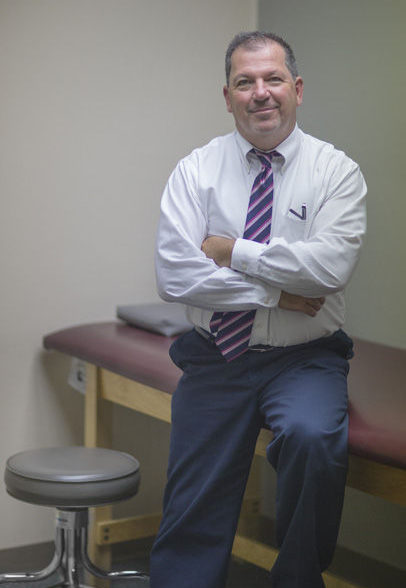
Hip fractures are serious injuries which typically result in severe pain, major surgical procedures and lengthy recovery periods; complications can be life-threatening. Such injuries occur most frequently in people 65 and older, who fall due to factors related to the aging process: weakened bones, increased medications, dizziness and vision issues among them.
The good news: There are ways individuals can lessen their chances of such an injury; and current medical procedures and high-tech replacement materials can mean better outcomes and less likelihood of complications should a hip fracture occur.
Dr. Robert J. Hill, D.O., is an orthopedic surgeon with offices in Vero Beach as well as Sebastian who sees patients in both places who present with arthritis and other bone and joint issues. Hill moved to the area six weeks ago from Cincinnati, where he served as Chief of Osteopathic Surgery at Mercy Hospital. He attended the Philadelphia College of Osteopathic Medicine and did his residency at Michigan State University followed by a Fellowship at the Cleveland Clinic Foundation.
Hill explained that, surprisingly, “everybody has osteoporosis. Everybody starts losing bone at around age 35 or so.” That’s when the body stops building bone, and there is “a normal, gradual loss.” But how much bone an individual has at that point, and how significant the loss will be going forward, is based, in large part, on that individual’s habits.
A person who has been physically active will typically have less bone loss. Weight-bearing exercises such as walking, running and jumping jacks are the main factor in bone health, Hill said.
Often, he noted, patients will tell him they get a lot of exercise by swimming every day. While swimming is great for the cardiovascular system, it does nothing to help strengthen bones, he explained. A good, all-round healthy diet is also important, he continued, not necessarily lots of calcium and other supplements, just a balanced diet, such as is suggested on the FDA website.
Hill spoke of his surprise at the difference in physical capability he has observed in elderly people in Florida, compared to those in Ohio. “I see someone walk into my office, under his/her own steam, at 85 or older, without needing help. They’ll say they have a joint pain they want to deal with so they can get back to their golf or tennis. That’s just fabulous. In Cincinnati, people of that age most often needed help from a walker or a family member. Here people can walk and exercise outside all year round. “
When a hip fracture occurs, said Hill, the treatment depends on precisely where the bone has been broken, in relation to the blood supply, crucial for bone health and repair. General anesthesia is typically given for these procedures. If the break is just below the neck of the femur (thighbone) a plate and rod or screws can be employed to repair the bone, allowing it to heal, with no artificial replacement required.
Should the break involve the ball of the hip joint, a partial hip replacement can be performed, called a hemiarthroplasty, to replace only the ball part of the hip joint. In that case, the patient can be up and moving “right away,” says Hill.
Should the break involve the entire joint, a full joint replacement may be required. In that case, the patient will need to allow at least six to eight weeks of “protective weight bearing,” using a walker and taking precautions until the area is completely healed.
With a full hip replacement, an artificial cartilage is inserted between the ball and cup segments. This is a polyethylene material which can wear out sooner than the metal. In that case, it can be replaced with a simple procedure.
Hill likes to see his hip replacement patients every couple years to check the stability of the joint and the replacement cartilage. As to the joint itself, it is expected to last as long as the patient. Hill says, “We don’t put them in thinking we will have to replace them. “
As increasing emphasis is put on school sports for both girls and boys, with great demand on their bodies, often with little if any summer breaks; and as people exercise and remain active well into their 60s and even 70s, there is more and more focus on alternatives to joint replacement.
While Hill is all for employing the very best proven techniques and materials in bone and joint repair and replacement, he isn’t one to jump on the current “new thing” bandwagon. He points out a time when ceramic joint replacements were The Big Thing, and were used on numerous patients instead of the traditional metal. Disaster ensued when, after a while, patient after patient suffered with cracked and broken ceramic replacement joints. In his surgical practice, Hill uses those procedures and materials that “have been proven – have stood the test of time. I want to see it done.”
“It’s a changing world,” he observes.



